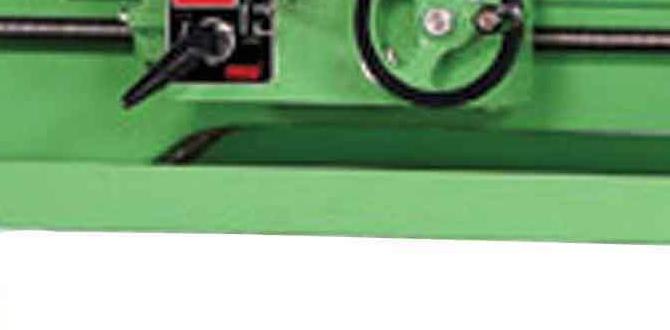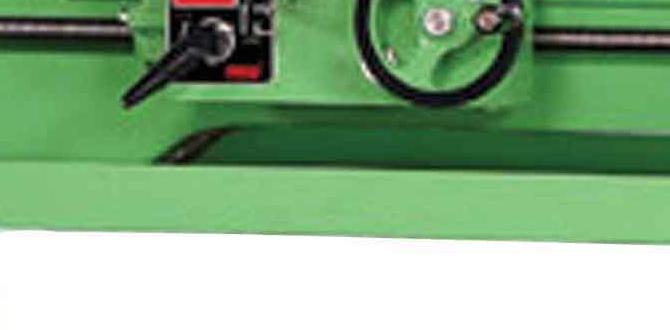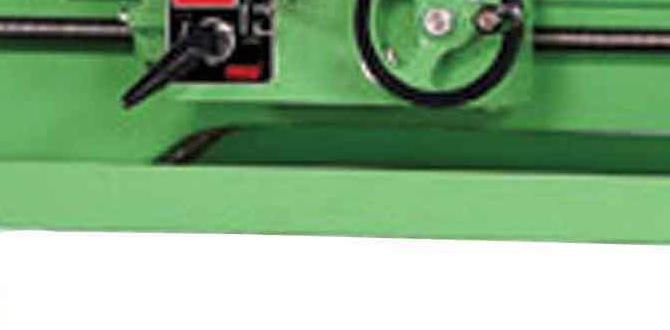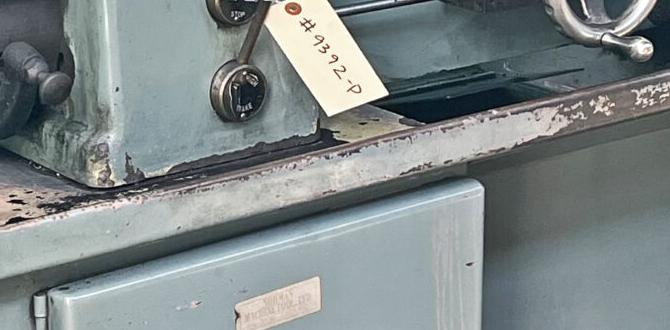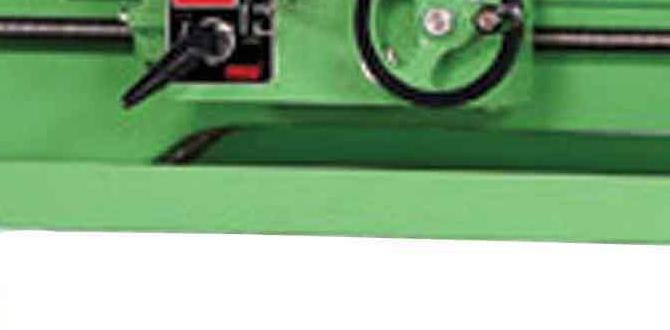Woodworking lathe projects for gifts offer unique, personalized, and handmade treasures. Discover proven ideas that are beginner-friendly, showcasing the beauty of turned wood to create memorable presents that impress.
Turning wood on a lathe can seem a bit intimidating at first, but with the right guidance, it’s a fantastic way to create something truly special. Many people think of complex, time-consuming pieces when they hear “lathe projects,” but the truth is, there are plenty of wonderful gift ideas perfect for beginners. Whether you’re making a gift for a friend, family member, or even just to sell at a local craft fair, a handmade wooden item from your lathe is always a thoughtful gesture.
This guide will walk you through some of the best woodworking lathe projects for gifts. We’ll focus on ideas that are achievable for those just starting out, while still yielding impressive results. You’ll learn about the types of projects suitable for newcomers and get inspiration to start creating beautiful, turned gifts that will be cherished for years to come.
Getting Started: What Makes a Good Lathe Gift Project?
When you’re thinking about woodworking lathe projects for gifts, especially for beginners, a few key points come to mind. You want something that looks great but doesn’t require advanced techniques or extremely difficult cuts. Durability, usability, and visual appeal are also important factors.
Here’s a quick rundown of what to look for in a good beginner lathe gift project:
- Simplicity of Form: Projects with straightforward shapes are easiest to master. Think bowls, spindles, and simple geometric forms.
- Manageable Size: Smaller projects are less intimidating and require less material. They also turn faster, giving you a sense of accomplishment sooner.
- Useful or Decorative: The best gifts serve a purpose or add beauty to a space. Consider everyday items or decorative pieces that showcase the wood’s natural grain.
- Low Material Cost: Starting with affordable wood is smart. Scraps or less expensive hardwoods are perfect for practice and gifts.
- Safety First: Always choose projects that allow for safe tool control and minimize the risk of catches or kickbacks.
Essential Tools for Beginner Lathe Projects
Before you even think about turning, make sure you have the basic tools. Don’t feel like you need the most expensive set out there to start. Good quality, sharp tools are key to success and safety. For most beginner projects, you’ll likely need:
- Wood Lathe: The centerpiece! For beginners, midi-lathes are excellent as they are compact and affordable, yet capable of handling many project sizes.
- Chisels (Gouges): At a minimum, you’ll want a few essential chisels. A spindle gouge is great for shaping, a roughing gouge for material removal, and a skew chisel for finishing.
- Faceplate and/or Chuck: These hold your wood securely on the lathe. A faceplate is simple for round stock, while a chuck offers more versatility for different shapes.
- Measuring Tools: A ruler or tape measure, and calipers are useful for precise dimensions.
- Safety Gear: This is non-negotiable. A full face shield, dust mask, and safety glasses are a must.
- Sanding Supplies: Sandpaper in various grits (from coarse to very fine) for smoothing.
- Finishing Supplies: Wax, oil, or lacquer to protect and enhance the wood.
Proven Woodworking Lathe Projects for Gifts (Beginner-Friendly!)
Let’s dive into some specific woodworking lathe projects for gifts that a beginner can tackle. These ideas are not only popular but also provide a great learning experience.
1. Simple Wooden Bowls
Bowls are a classic woodworking lathe project, and for good reason. Their open shape makes them accessible for beginners, and the results can be stunning. You can create small candy dishes, decorative accent bowls, or even larger serving bowls depending on your lathe’s capacity.
What You’ll Need:
- A block of wood (hardwoods like maple or cherry are great).
- Lathe and essential chisels.
- Faceplate or chuck.
- Sandpaper.
- Food-safe finish (if intended for food use).
Basic Steps:
- Mount the Wood: Securely attach your wood block to the lathe using a faceplate or chuck.
- Rough Shape: Use a roughing gouge to turn the block into a roughly cylindrical shape, then begin to form the outer curve of the bowl.
- Hollow the Inside: Carefully use a bowl gouge to hollow out the inside of the bowl. Work in shallow passes, gradually deepening the cavity.
- Refine Shape: Use a skew or parting tool to define the rim and base.
- Sand: Once the shape is complete, sand the bowl thoroughly, starting with coarser grits and moving to finer ones for a smooth finish.
- Apply Finish: Apply a food-safe finish like mineral oil or beeswax if it’s for food, or a lacquer/varnish for decorative bowls.
Tips for Beginners:
- Don’t try to make the walls too thin on your first attempt.
- Take shallow cuts. It’s better to make many small cuts than one deep, problematic one.
- Practice on scrap wood first.
2. Spindle Turned Candlesticks
Candlesticks are elegant and relatively simple to turn. They rely on creating a series of beads, coves, and cylinders along a spindle. These are fantastic for practicing your tool control and creating smooth, flowing lines.
What You’ll Need:
- A length of straight-grained wood (pine or poplar are good, but hardwoods like walnut look spectacular).
- Lathe and chisels (spindle gouge and skew are very useful here).
- Tailstock center for support.
- Sandpaper and finish.
Basic Steps:
- Prepare Stock: Cut your wood to length and square off the ends. Mount it between centers (headstock and tailstock).
- Shape the Spindle: Begin by removing waste to create a cylinder, then use your spindle gouge and skew chisel to create the desired shapes—beads, coves, parallel sections, etc.
- Check for Fit: Ensure the candle holder at the top is the right size for a standard candle.
- Sand: Sand the entire piece smooth, paying attention to the transitions between different shapes.
- Apply Finish: Apply your chosen finish.
Tips for Beginners:
- Measure and mark your bead and cove locations before you start cutting.
- Practice making beads and coves on scrap pieces to get a feel for the tools.
- Ensure the tailstock is snug against the wood for good support.
3. Wooden Pens
Making a wooden pen is one of the most popular and accessible woodworking lathe projects for gifts. Pen kits are readily available and have pre-made mechanisms, so all you need to do is turn the wood around the insert. This project is excellent for practicing turning small diameters and achieving a high-quality finish.
What You’ll Need:
- A pen kit (with tube insert).
- A small piece of wood (hardwoods like maple, walnut, or exotic woods work well).
- A drill (for drilling the wood blank).
- Lathe and bushings for the specific pen kit.
- Sandpaper and a durable finish (like CA glue or lacquer).
Basic Steps:
- Prepare the Blank: Drill the wood blank to the diameter specified by the pen kit instructions. Insert the brass tubes from the kit.
- Mount and Turn: Insert the tubes with wood into the pen mandrel (or bushings on your lathe). Turn the wood down to the diameter of the bushings, shaping it as desired.
- Sand and Finish: Sand the wood smooth, often using a stepped process with fine grits. Apply a durable finish like cyanoacrylate (CA) glue for a glossy, protective coating.
- Assemble: Once the finish is cured, assemble the pen components according to the kit’s instructions.
Tips for Beginners:
- Ensure your drill bit is sharp and perpendicular to the wood blank.
- Use the correct bushings for your pen kit to ensure proper fit.
- Take light passes when turning to avoid tearing out the wood around the tubes.
4. Small Decorative Boxes
Small lidded boxes are another fantastic gift idea. You can turn the box and lid separately, creating a snug fit. This project hones your precision turning skills and allows for creative lid designs.
What You’ll Need:
- Wood for the box body and lid.
- Lathe and chisels.
- Faceplate or chuck.
- Measuring tools for precise fitting.
- Sandpaper and finish.
Basic Steps:
- Turn the Box Body: Mount the wood, turn the outside, and then hollow out the inside. Aim for a consistent wall thickness.
- Create the Lid Seat: Carefully turn a lip or recess on the top edge of the box body where the lid will sit. This needs to be very precise.
- Turn the Lid: Mount another piece of wood, turn the outside to match the box opening, and create the underside to fit snugly into the lid seat.
- Refine Fit: Test the fit of the lid frequently. Make small adjustments as needed.
- Sand and Finish: Sand both parts separately and apply finish.
Tips for Beginners:
- Start with a slightly oversized lid and carefully turn it down until it fits.
- Consider a simple friction-fit lid first, rather than one with intricate joinery.
- Use calipers to ensure consistent dimensions for the lid and the box’s seating lip.
5. Wooden Spoons and Ladles
While often carved, spoons and ladles can also be turned on a lathe, especially the handles and the basic bowl shape. This offers a chance to work with different wood types and create ergonomic designs.
What You’ll Need:
- Wood suitable for kitchenware (maple, cherry, or walnut are good choices).
- Lathe and specialized spoon gouges or a combination of standard chisels.
- Tailstock support.
- Sandpaper and food-safe finish.
Basic Steps:
- Prepare Handle: Mount a piece of wood between centers and turn a comfortable handle.
- Form the Bowl: For a ladle, you might attach a faceplate to a larger piece of wood and hollow out a bowl shape. For spoons, the bowl is often shaped by hand or with a specialized spoon gouge.
- Join Handle and Bowl (if separate): If you turned them separately, you’ll need a way to join them securely. Or, for a simple ladle, you can turn the handle directly from the bowl blank if the wood is large enough.
- Refine and Sand: Smooth all surfaces and edges.
- Apply Finish: Use a food-safe oil or wax.
Tips for Beginners:
- Focus on making a comfortable handle first.
- If tackling a spoon, consider a pre-made blank for the bowl to simplify the process.
- Always use food-safe finishes for items that will come into contact with food.
- You can find excellent resources on safe wood choices for kitchenware from organizations like the U.S. Forest Service, which details properties of various wood species.
6. Simple Vases and Bud Vases
Similar to bowls, vases are another excellent project for beginners. Their often columnar shape with a narrower opening is achievable and results in elegant decorative items.
What You’ll Need:
- Wood (hardwoods like mahogany or oak look great).
- Lathe and chisels (spindle gouge is key).
- Sandpaper and finish.
Basic Steps:
- Mount and Shape: Mount your wood and rough it into a cylindrical form.
- Form the Neck and Body: Use your spindle gouge to create the curves of the vase. Think about a wider base and a narrower opening.
- Hollow (if applicable): For a hollow vase with a narrow opening, this can be trickier. For beginners, a solid decorative vase is often easier.
- Sand and Finish: Smooth the entire piece and apply a beautiful finish.
Tips for Beginners:
- Don’t make the neck too narrow on your first attempt, as it can be hard to work with tools.
- Consider creating a solid decorative vase first, then move on to hollow forms.
- The grain pattern of the wood can really make a vase pop.
Understanding Wood Selection for Gifts
The type of wood you choose can significantly impact the final look and feel of your gift. For beginners, focusing on stable, easy-to-turn hardwoods is a smart move.
Good Woods for Beginner Projects:
- Maple: Hard, stable, and has a fine, even grain that sands smoothly. It takes finishes beautifully and is great for bowls, pens, and spindles.
- Cherry: A bit softer than maple but still turns well. It has a lovely reddish hue that deepens with age and is popular for bowls and decorative items.
- Walnut: Dark, rich, and fairly easy to turn. Its striking grain patterns make it a favorite for pens, boxes, and decorative pieces.
- Poplar or Pine: Softer woods that are very forgiving for practice. They are less durable and may dent more easily but are inexpensive and easy to work with for learning.
Woods to Approach with Caution (or Avoid as a Beginner):
- Very Oily Woods (like Teak): Can be challenging to finish as the oils can interfere with glue and finishes.
- Extremely Hard Woods (like Ipe): Can be tough on your tools and require more effort.
- Highly Figured Woods (like Quilted Maple): While beautiful, they can be prone to tear-out and require careful technique.
Finishing Touches: Making Your Gifts Shine
The way you finish your turned pieces can elevate them from simple wooden objects to cherished gifts. A good finish protects the wood, enhances its natural beauty, and adds a professional touch.
Common Finishes and Their Uses:
| Finish Type | Description | Best For | Beginner Friendliness |
|---|---|---|---|
| Mineral Oil | A simple, food-safe oil that penetrates the wood. Requires reapplication. | Bowls, spatulas, cutting boards (items that may touch food). | Very Easy |
| Beeswax/Carnauba Wax | Often applied over oil or used alone for a soft sheen and mild protection. | All wood items, especially those finished with oil. Adds a slight sheen. | Easy |
| Deft/Lacquer | A spray-on finish that dries quickly and provides a durable, glossy coat. | Decorative items, vases, boxes, pen bodies. Not ideal for food. | Moderate (requires ventilation and spray technique) |
| CA Glue (Cyanoacrylate) | “Super glue.” Creates a very hard, |

